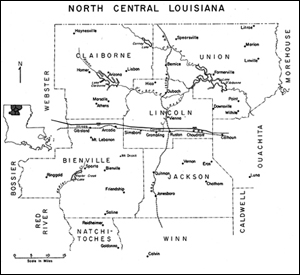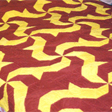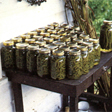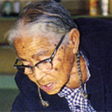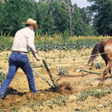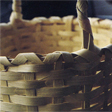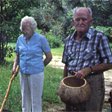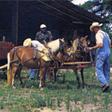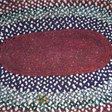Edited by Susan Roach
[Revised in 2002. Originally published in 1984 as an exhibition catalog.]

Introduction
By Susan Roach
The North Central Louisiana Folklife Project was begun in November, 1983 for the purpose of surveying and documenting the existing folk traditions located in the five parishes of Bienville, Claiborne, Jackson, Lincoln, and Union. With Lincoln as the hub, the five parishes share common geographic characteristics such as landscape, high rural population, and the absence of major metropolitan areas. Drained by small creeks and bayous, the gently rolling pine-covered hills of north central Louisiana boast the highest point in the state. Driskill Mountain in Bienville Parish, at 535 feet above sea level. Although the hills are small, they offer a marked contrast to the lowlands of South Louisiana; consequently, the upland area of the state is known locally as the "hill country" or as the area's newly formed tourist promotional organization named itself, the "Piney Hills Country." Many of the local rural inhabitants also refer to themselves as "hill country people" or "just simple country folks."
The selection of this area for folklife research, although somewhat arbitrary, was made because of the accessibility of the area to Louisiana Tech and because of the richness of its folklife, which had received little previous scholarly attention.
The scope of this project can be better understood if a few definitions are provided. For our purposes, folklife may be briefly defined as the traditional ways, customs, skills and other cultural materials that are passed down over time in families, churches, and communities, or occupations without the aid of formal academic schooling, popular workshops and classes, or the mass media. Folk traditions fall into a number of general categories, or genres, including verbal arts (oral history, jokes, riddles, dialect, tall tales, legends, myth, personal anecdotes, etc.), religious rituals, festivals, folk music and dance, folk medicine and beliefs, foodways, folk arts and crafts, traditional architecture, and land use (farming, fishing, hunting, trapping techniques, etc.). Folklife is ultimately conservative in that it is slow to change, being more concerned with the repetition of forms rather than in creating new forms. However, there is also room for creativity and innovation.
More broadly defined, modern folkloristics encompasses the ethnographic description of expressive culture and communicative behavior. However, the focus of this project is limited to the regional folklife of the north central Louisiana area; that is, it does not consider all the folklore forms that occur in the area such as urban, occupational or ethnic lore, such as xerox humor, ethnic jokes, or children's scary stories, which all fall under the academic umbrella of folklore. Although also important, these forms with less depth in time, are not as endangered as rural folklife.
In the discipline of folklore, regional folklife is the term given to similar cultural traditions developed by people who have lived in one rural area for several generations. In the case of north central Louisiana, most of the people are descended from settlers from other parts of the deep South, an area usually considered a folk region by folklorists and anthropologists. Consequently, the folk traditions of the area are rooted in those of the deep South. Because of its slow industrial growth and its rural population, north central Louisiana has maintained many southern folkways, while many Southern areas are lamenting the death of these traditions.
In hopes of preserving these endangered cultural resources, a number of national and state programs have been initiated. The North Central Louisiana Folklife Project is one result of such programs in Louisiana. It is the hope that the identification, documentation, and presentation of folk culture will not only preserve for historical purposes the elements of traditional culture in a permanent documentary form, but also will conserve and keep these traditions alive by encouraging them and providing similar attention and monies previously awarded only to elite culture.
The present project has consisted of three phases directed toward these goals. First of all, it has surveyed the existing folklife in its context found in the north central Louisiana area and secondly, provided documentation through photographs, tape recordings, and survey forms. These documents will then be preserved in the Louisiana Tech Louisiana Archives. Finally, the project is presenting the findings to the public in three forums-this catalog, the exhibition, and folklife demonstrations at the Ruston Centennial Heritage Day.
The exhibition, which this catalog accompanies presented a number of objects and foodways still being produced in the area. The exhibition also included documentary photographs of the traditions and their practitioners in context. Although not all the region's traditions were documented fully because of their seasonal inaccessibility, a number of the folklife genres are presented in some depth with serial photographs.
Since space limitations in the catalog preclude the presentation of the detailed data on the many folk traditions documented in the project, we provide instead a general frame for interpretation which gives overviews of the north central Louisiana history, essential because the project's regional focus, and the area folklife with examples and illustrations drawn from the data. Likewise, although the catalog cannot present photographs of all the objects in the exhibition and all the traditions documented in the research, it does attempt to give a sampling of the wide range of traditions covered by the project folklorist fieldworker. Rather than concentrating only on the objects of the exhibition, the photographs presented here focus on the maker of the object, its production, and use or on the performers of folk tradition and the context of the performance. The more humanistic approach to the data, hopefully, will put the viewer in closer touch with the tradition bearers and, thereby, promote a greater understanding and appreciation of the vitality and complexities of the folk process and the heritage of the hill country.


